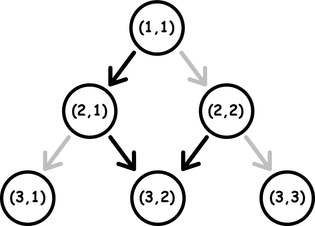CF1506F.Triangular Paths
普及/提高-
通过率:0%
AC君温馨提醒
该题目为【codeforces】题库的题目,您提交的代码将被提交至codeforces进行远程评测,并由ACGO抓取测评结果后进行展示。由于远程测评的测评机由其他平台提供,我们无法保证该服务的稳定性,若提交后无反应,请等待一段时间后再进行重试。
题目描述
Consider an infinite triangle made up of layers. Let's number the layers, starting from one, from the top of the triangle (from top to bottom). The k -th layer of the triangle contains k points, numbered from left to right. Each point of an infinite triangle is described by a pair of numbers (r,c) ( 1≤c≤r ), where r is the number of the layer, and c is the number of the point in the layer. From each point (r,c) there are two directed edges to the points (r+1,c) and (r+1,c+1) , but only one of the edges is activated. If r+c is even, then the edge to the point (r+1,c) is activated, otherwise the edge to the point (r+1,c+1) is activated. Look at the picture for a better understanding.
 Activated edges are colored in black. Non-activated edges are colored in gray.From the point (r1,c1) it is possible to reach the point (r2,c2) , if there is a path between them only from activated edges. For example, in the picture above, there is a path from (1,1) to (3,2) , but there is no path from (2,1) to (1,1) .
Activated edges are colored in black. Non-activated edges are colored in gray.From the point (r1,c1) it is possible to reach the point (r2,c2) , if there is a path between them only from activated edges. For example, in the picture above, there is a path from (1,1) to (3,2) , but there is no path from (2,1) to (1,1) .
Initially, you are at the point (1,1) . For each turn, you can:
- Replace activated edge for point (r,c) . That is if the edge to the point (r+1,c) is activated, then instead of it, the edge to the point (r+1,c+1) becomes activated, otherwise if the edge to the point (r+1,c+1) , then instead if it, the edge to the point (r+1,c) becomes activated. This action increases the cost of the path by 1 ;
- Move from the current point to another by following the activated edge. This action does not increase the cost of the path.
You are given a sequence of n points of an infinite triangle (r1,c1),(r2,c2),…,(rn,cn) . Find the minimum cost path from (1,1) , passing through all n points in arbitrary order.
输入格式
The first line contains one integer t ( 1≤t≤104 ) is the number of test cases. Then t test cases follow.
Each test case begins with a line containing one integer n ( 1≤n≤2⋅105 ) is the number of points to visit.
The second line contains n numbers r1,r2,…,rn ( 1≤ri≤109 ), where ri is the number of the layer in which i -th point is located.
The third line contains n numbers c1,c2,…,cn ( 1≤ci≤ri ), where ci is the number of the i -th point in the ri layer.
It is guaranteed that all n points are distinct.
It is guaranteed that there is always at least one way to traverse all n points.
It is guaranteed that the sum of n over all test cases does not exceed 2⋅105 .
输出格式
For each test case, output the minimum cost of a path passing through all points in the corresponding test case.
输入输出样例
输入#1
4 3 1 4 2 1 3 1 2 2 4 2 3 2 1 1000000000 1 1000000000 4 3 10 5 8 2 5 2 4
输出#1
0 1 999999999 2